Exploring Media Representations of Indigenous Health in Australia
VerifiedAdded on 2022/12/28
|9
|2334
|73
Essay
AI Summary
This essay examines the portrayal of Indigenous Australian health issues in various media outlets, including newspapers, television, and websites. It explores how these media platforms represent health concerns such as nutrition, alcohol consumption, child abuse, mental health, smoking, and crime. The essay analyzes the negative, positive, and neutral qualities of media coverage, highlighting the impact on self-esteem and public perception. It discusses the use of different media types to convey information, including the role of newspapers in reporting nutrition issues and the visual representation of health on television. The analysis also covers social media's impact and how it influences the community's understanding of health and well-being. The study concludes by emphasizing the media's crucial role in shaping the relationship between mainstream society and Indigenous Australians and advocates for introducing courses to address false beliefs and prejudice.
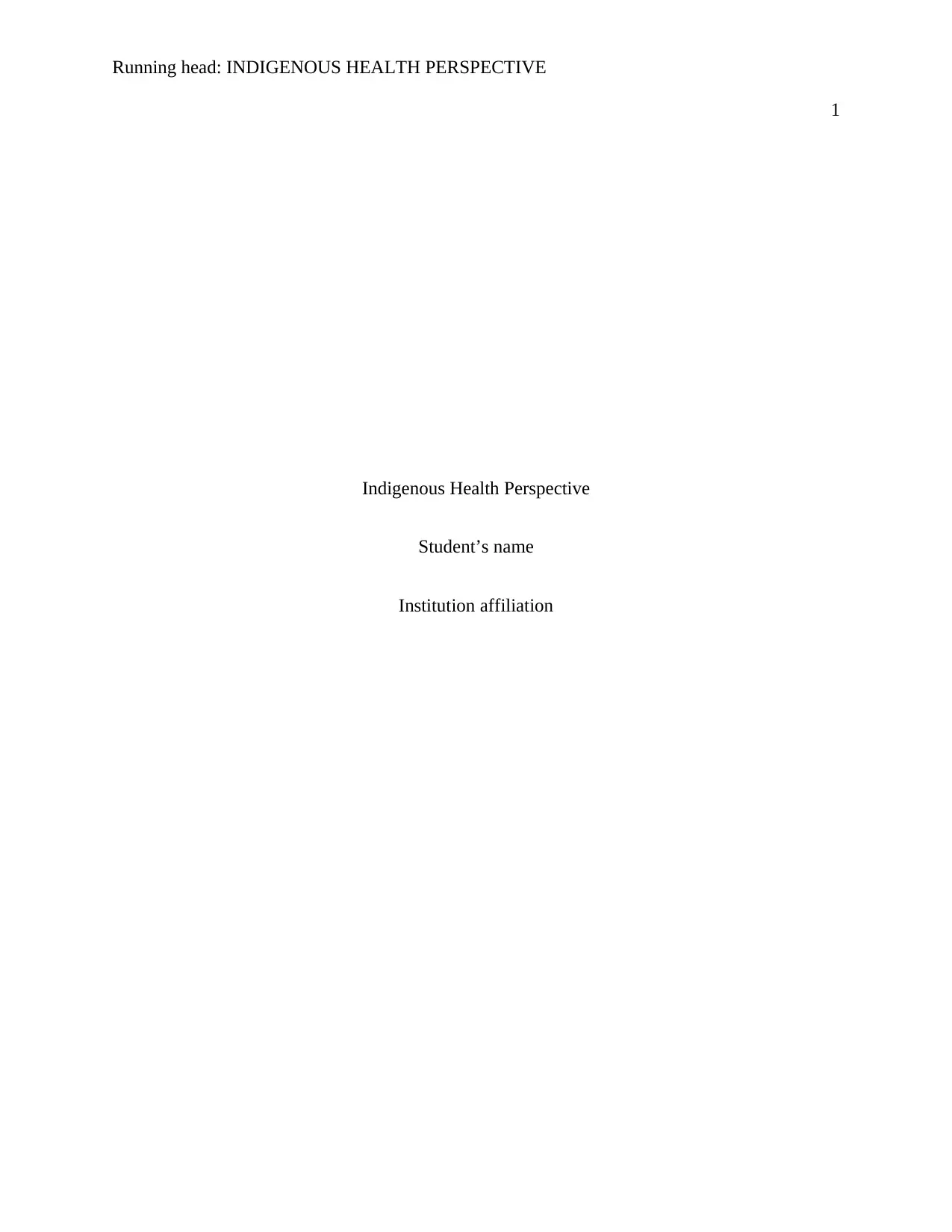
Running head: INDIGENOUS HEALTH PERSPECTIVE
1
Indigenous Health Perspective
Student’s name
Institution affiliation
1
Indigenous Health Perspective
Student’s name
Institution affiliation
Paraphrase This Document
Need a fresh take? Get an instant paraphrase of this document with our AI Paraphraser
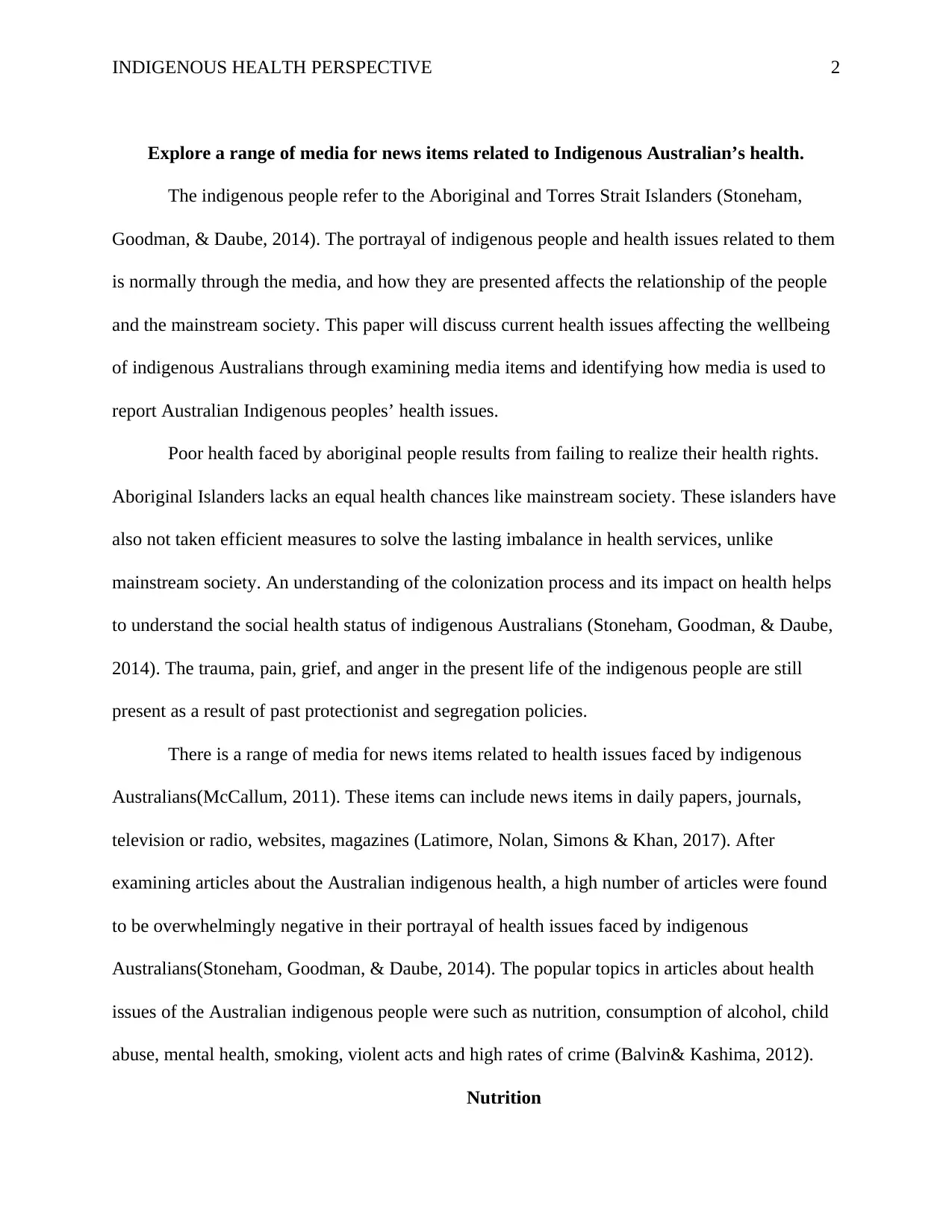
INDIGENOUS HEALTH PERSPECTIVE 2
Explore a range of media for news items related to Indigenous Australian’s health.
The indigenous people refer to the Aboriginal and Torres Strait Islanders (Stoneham,
Goodman, & Daube, 2014). The portrayal of indigenous people and health issues related to them
is normally through the media, and how they are presented affects the relationship of the people
and the mainstream society. This paper will discuss current health issues affecting the wellbeing
of indigenous Australians through examining media items and identifying how media is used to
report Australian Indigenous peoples’ health issues.
Poor health faced by aboriginal people results from failing to realize their health rights.
Aboriginal Islanders lacks an equal health chances like mainstream society. These islanders have
also not taken efficient measures to solve the lasting imbalance in health services, unlike
mainstream society. An understanding of the colonization process and its impact on health helps
to understand the social health status of indigenous Australians (Stoneham, Goodman, & Daube,
2014). The trauma, pain, grief, and anger in the present life of the indigenous people are still
present as a result of past protectionist and segregation policies.
There is a range of media for news items related to health issues faced by indigenous
Australians(McCallum, 2011). These items can include news items in daily papers, journals,
television or radio, websites, magazines (Latimore, Nolan, Simons & Khan, 2017). After
examining articles about the Australian indigenous health, a high number of articles were found
to be overwhelmingly negative in their portrayal of health issues faced by indigenous
Australians(Stoneham, Goodman, & Daube, 2014). The popular topics in articles about health
issues of the Australian indigenous people were such as nutrition, consumption of alcohol, child
abuse, mental health, smoking, violent acts and high rates of crime (Balvin& Kashima, 2012).
Nutrition
Explore a range of media for news items related to Indigenous Australian’s health.
The indigenous people refer to the Aboriginal and Torres Strait Islanders (Stoneham,
Goodman, & Daube, 2014). The portrayal of indigenous people and health issues related to them
is normally through the media, and how they are presented affects the relationship of the people
and the mainstream society. This paper will discuss current health issues affecting the wellbeing
of indigenous Australians through examining media items and identifying how media is used to
report Australian Indigenous peoples’ health issues.
Poor health faced by aboriginal people results from failing to realize their health rights.
Aboriginal Islanders lacks an equal health chances like mainstream society. These islanders have
also not taken efficient measures to solve the lasting imbalance in health services, unlike
mainstream society. An understanding of the colonization process and its impact on health helps
to understand the social health status of indigenous Australians (Stoneham, Goodman, & Daube,
2014). The trauma, pain, grief, and anger in the present life of the indigenous people are still
present as a result of past protectionist and segregation policies.
There is a range of media for news items related to health issues faced by indigenous
Australians(McCallum, 2011). These items can include news items in daily papers, journals,
television or radio, websites, magazines (Latimore, Nolan, Simons & Khan, 2017). After
examining articles about the Australian indigenous health, a high number of articles were found
to be overwhelmingly negative in their portrayal of health issues faced by indigenous
Australians(Stoneham, Goodman, & Daube, 2014). The popular topics in articles about health
issues of the Australian indigenous people were such as nutrition, consumption of alcohol, child
abuse, mental health, smoking, violent acts and high rates of crime (Balvin& Kashima, 2012).
Nutrition
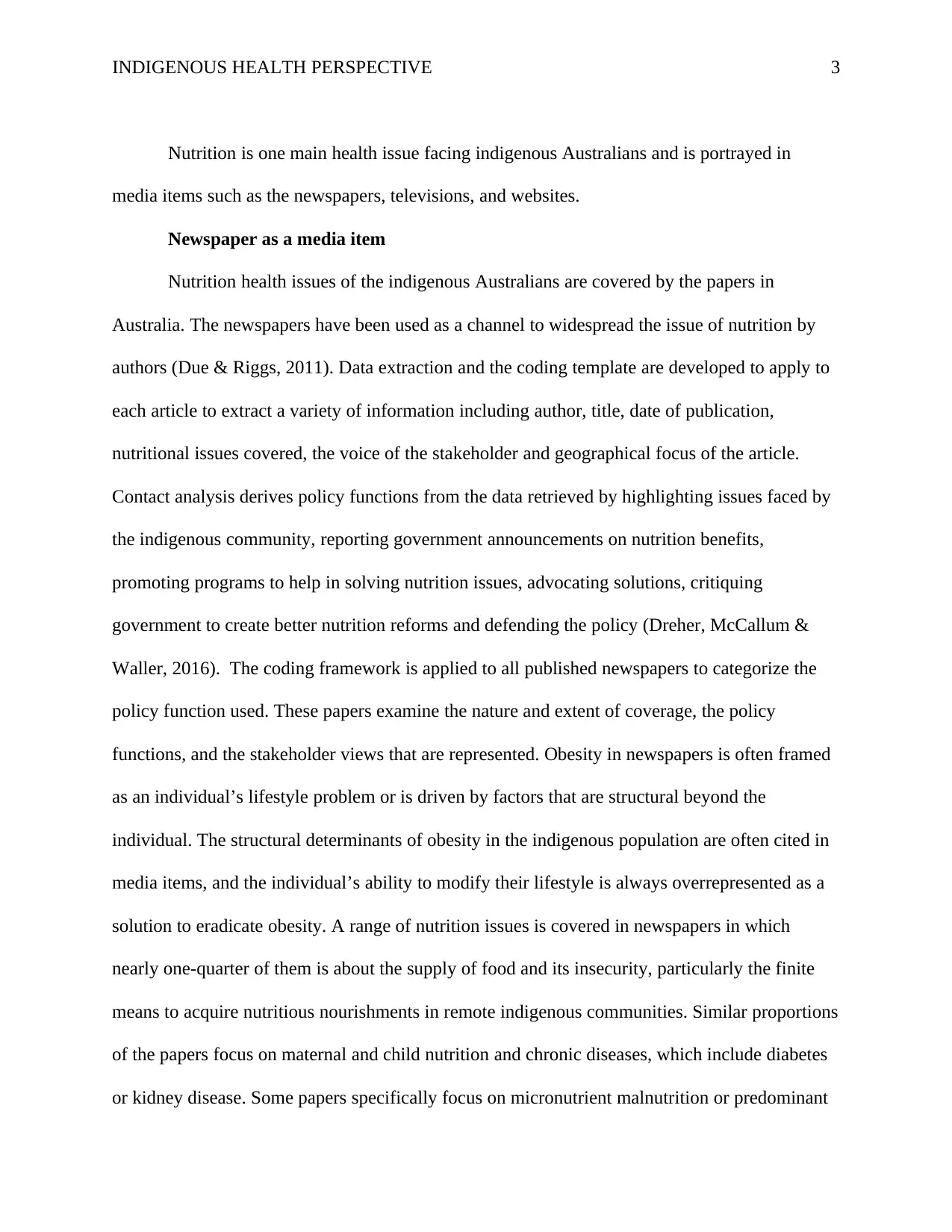
INDIGENOUS HEALTH PERSPECTIVE 3
Nutrition is one main health issue facing indigenous Australians and is portrayed in
media items such as the newspapers, televisions, and websites.
Newspaper as a media item
Nutrition health issues of the indigenous Australians are covered by the papers in
Australia. The newspapers have been used as a channel to widespread the issue of nutrition by
authors (Due & Riggs, 2011). Data extraction and the coding template are developed to apply to
each article to extract a variety of information including author, title, date of publication,
nutritional issues covered, the voice of the stakeholder and geographical focus of the article.
Contact analysis derives policy functions from the data retrieved by highlighting issues faced by
the indigenous community, reporting government announcements on nutrition benefits,
promoting programs to help in solving nutrition issues, advocating solutions, critiquing
government to create better nutrition reforms and defending the policy (Dreher, McCallum &
Waller, 2016). The coding framework is applied to all published newspapers to categorize the
policy function used. These papers examine the nature and extent of coverage, the policy
functions, and the stakeholder views that are represented. Obesity in newspapers is often framed
as an individual’s lifestyle problem or is driven by factors that are structural beyond the
individual. The structural determinants of obesity in the indigenous population are often cited in
media items, and the individual’s ability to modify their lifestyle is always overrepresented as a
solution to eradicate obesity. A range of nutrition issues is covered in newspapers in which
nearly one-quarter of them is about the supply of food and its insecurity, particularly the finite
means to acquire nutritious nourishments in remote indigenous communities. Similar proportions
of the papers focus on maternal and child nutrition and chronic diseases, which include diabetes
or kidney disease. Some papers specifically focus on micronutrient malnutrition or predominant
Nutrition is one main health issue facing indigenous Australians and is portrayed in
media items such as the newspapers, televisions, and websites.
Newspaper as a media item
Nutrition health issues of the indigenous Australians are covered by the papers in
Australia. The newspapers have been used as a channel to widespread the issue of nutrition by
authors (Due & Riggs, 2011). Data extraction and the coding template are developed to apply to
each article to extract a variety of information including author, title, date of publication,
nutritional issues covered, the voice of the stakeholder and geographical focus of the article.
Contact analysis derives policy functions from the data retrieved by highlighting issues faced by
the indigenous community, reporting government announcements on nutrition benefits,
promoting programs to help in solving nutrition issues, advocating solutions, critiquing
government to create better nutrition reforms and defending the policy (Dreher, McCallum &
Waller, 2016). The coding framework is applied to all published newspapers to categorize the
policy function used. These papers examine the nature and extent of coverage, the policy
functions, and the stakeholder views that are represented. Obesity in newspapers is often framed
as an individual’s lifestyle problem or is driven by factors that are structural beyond the
individual. The structural determinants of obesity in the indigenous population are often cited in
media items, and the individual’s ability to modify their lifestyle is always overrepresented as a
solution to eradicate obesity. A range of nutrition issues is covered in newspapers in which
nearly one-quarter of them is about the supply of food and its insecurity, particularly the finite
means to acquire nutritious nourishments in remote indigenous communities. Similar proportions
of the papers focus on maternal and child nutrition and chronic diseases, which include diabetes
or kidney disease. Some papers specifically focus on micronutrient malnutrition or predominant
⊘ This is a preview!⊘
Do you want full access?
Subscribe today to unlock all pages.

Trusted by 1+ million students worldwide
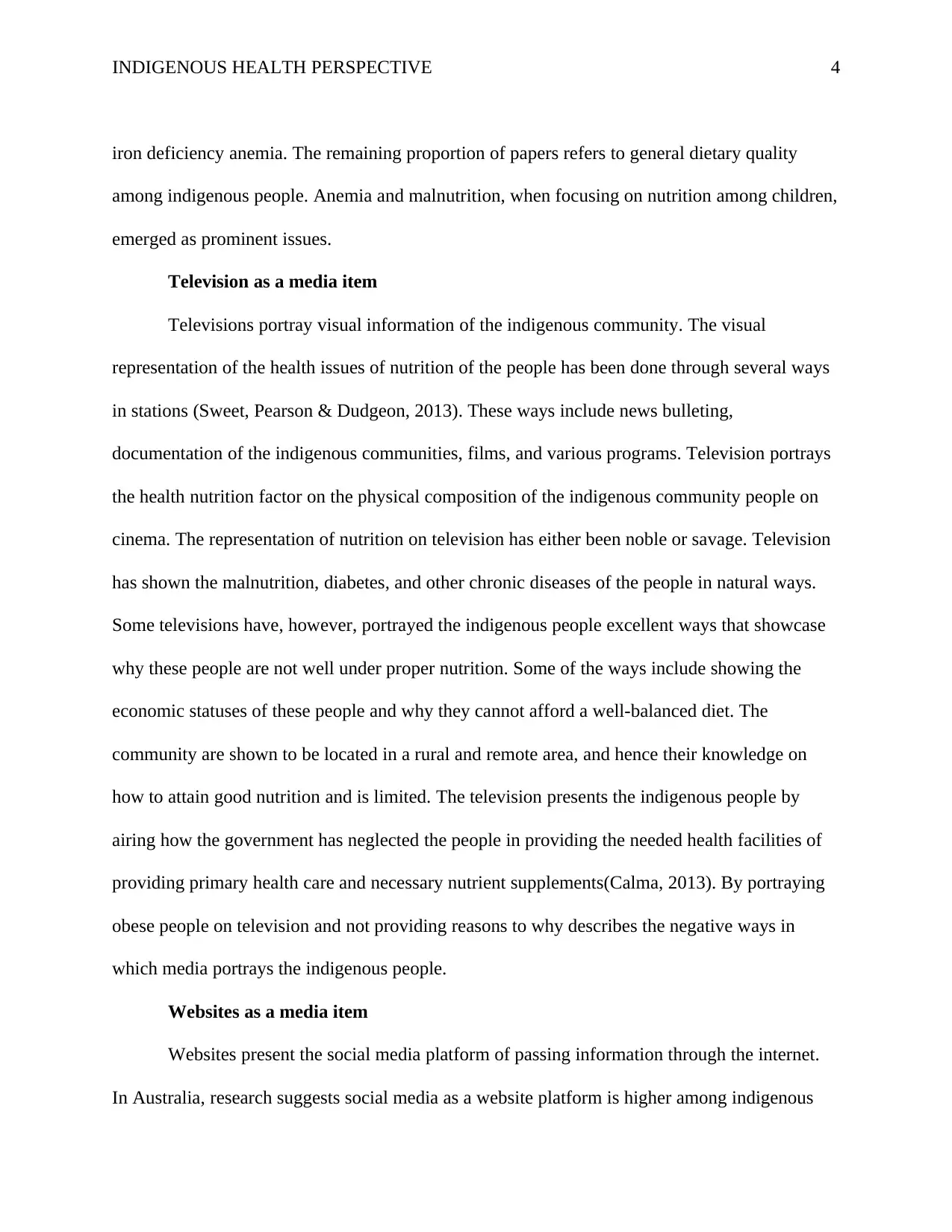
INDIGENOUS HEALTH PERSPECTIVE 4
iron deficiency anemia. The remaining proportion of papers refers to general dietary quality
among indigenous people. Anemia and malnutrition, when focusing on nutrition among children,
emerged as prominent issues.
Television as a media item
Televisions portray visual information of the indigenous community. The visual
representation of the health issues of nutrition of the people has been done through several ways
in stations (Sweet, Pearson & Dudgeon, 2013). These ways include news bulleting,
documentation of the indigenous communities, films, and various programs. Television portrays
the health nutrition factor on the physical composition of the indigenous community people on
cinema. The representation of nutrition on television has either been noble or savage. Television
has shown the malnutrition, diabetes, and other chronic diseases of the people in natural ways.
Some televisions have, however, portrayed the indigenous people excellent ways that showcase
why these people are not well under proper nutrition. Some of the ways include showing the
economic statuses of these people and why they cannot afford a well-balanced diet. The
community are shown to be located in a rural and remote area, and hence their knowledge on
how to attain good nutrition and is limited. The television presents the indigenous people by
airing how the government has neglected the people in providing the needed health facilities of
providing primary health care and necessary nutrient supplements(Calma, 2013). By portraying
obese people on television and not providing reasons to why describes the negative ways in
which media portrays the indigenous people.
Websites as a media item
Websites present the social media platform of passing information through the internet.
In Australia, research suggests social media as a website platform is higher among indigenous
iron deficiency anemia. The remaining proportion of papers refers to general dietary quality
among indigenous people. Anemia and malnutrition, when focusing on nutrition among children,
emerged as prominent issues.
Television as a media item
Televisions portray visual information of the indigenous community. The visual
representation of the health issues of nutrition of the people has been done through several ways
in stations (Sweet, Pearson & Dudgeon, 2013). These ways include news bulleting,
documentation of the indigenous communities, films, and various programs. Television portrays
the health nutrition factor on the physical composition of the indigenous community people on
cinema. The representation of nutrition on television has either been noble or savage. Television
has shown the malnutrition, diabetes, and other chronic diseases of the people in natural ways.
Some televisions have, however, portrayed the indigenous people excellent ways that showcase
why these people are not well under proper nutrition. Some of the ways include showing the
economic statuses of these people and why they cannot afford a well-balanced diet. The
community are shown to be located in a rural and remote area, and hence their knowledge on
how to attain good nutrition and is limited. The television presents the indigenous people by
airing how the government has neglected the people in providing the needed health facilities of
providing primary health care and necessary nutrient supplements(Calma, 2013). By portraying
obese people on television and not providing reasons to why describes the negative ways in
which media portrays the indigenous people.
Websites as a media item
Websites present the social media platform of passing information through the internet.
In Australia, research suggests social media as a website platform is higher among indigenous
Paraphrase This Document
Need a fresh take? Get an instant paraphrase of this document with our AI Paraphraser
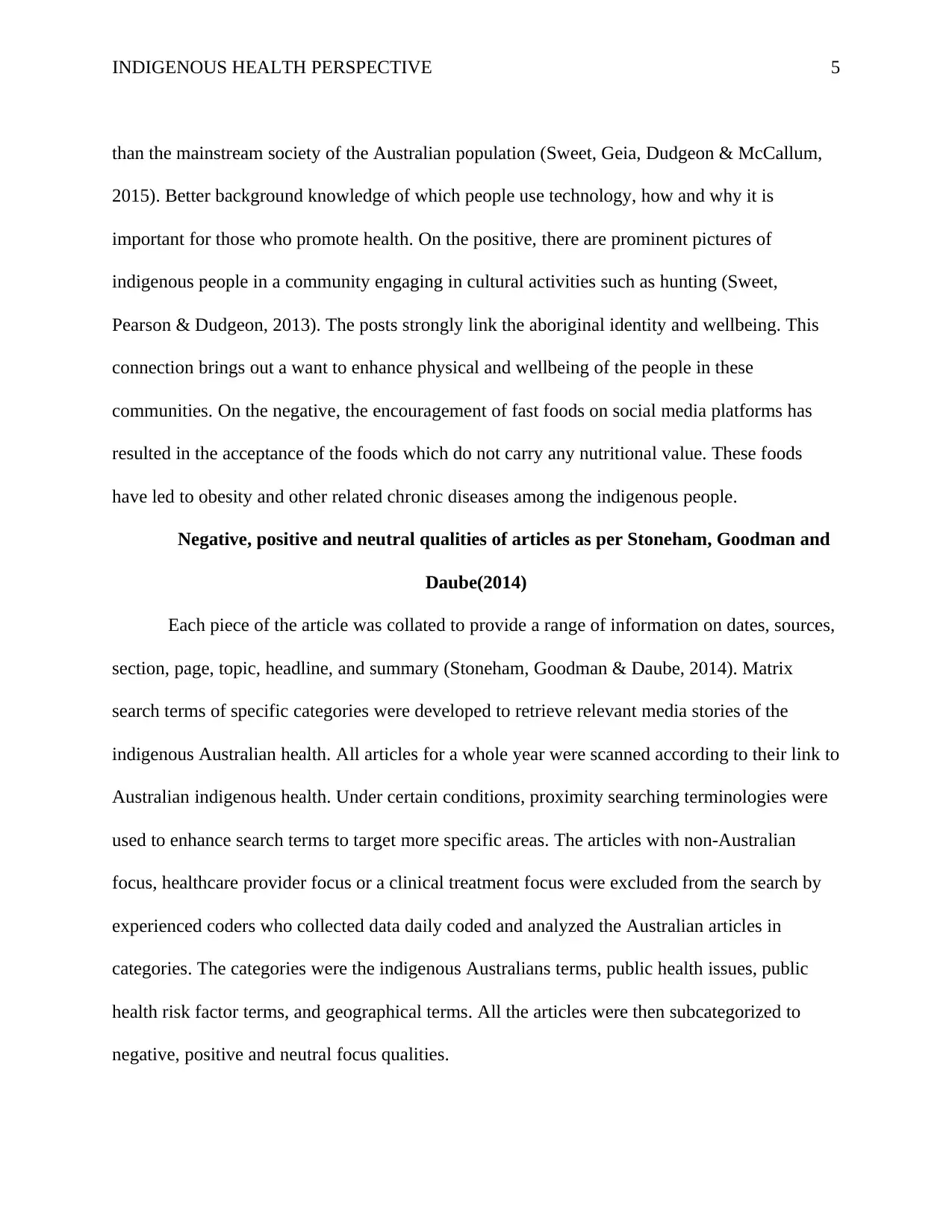
INDIGENOUS HEALTH PERSPECTIVE 5
than the mainstream society of the Australian population (Sweet, Geia, Dudgeon & McCallum,
2015). Better background knowledge of which people use technology, how and why it is
important for those who promote health. On the positive, there are prominent pictures of
indigenous people in a community engaging in cultural activities such as hunting (Sweet,
Pearson & Dudgeon, 2013). The posts strongly link the aboriginal identity and wellbeing. This
connection brings out a want to enhance physical and wellbeing of the people in these
communities. On the negative, the encouragement of fast foods on social media platforms has
resulted in the acceptance of the foods which do not carry any nutritional value. These foods
have led to obesity and other related chronic diseases among the indigenous people.
Negative, positive and neutral qualities of articles as per Stoneham, Goodman and
Daube(2014)
Each piece of the article was collated to provide a range of information on dates, sources,
section, page, topic, headline, and summary (Stoneham, Goodman & Daube, 2014). Matrix
search terms of specific categories were developed to retrieve relevant media stories of the
indigenous Australian health. All articles for a whole year were scanned according to their link to
Australian indigenous health. Under certain conditions, proximity searching terminologies were
used to enhance search terms to target more specific areas. The articles with non-Australian
focus, healthcare provider focus or a clinical treatment focus were excluded from the search by
experienced coders who collected data daily coded and analyzed the Australian articles in
categories. The categories were the indigenous Australians terms, public health issues, public
health risk factor terms, and geographical terms. All the articles were then subcategorized to
negative, positive and neutral focus qualities.
than the mainstream society of the Australian population (Sweet, Geia, Dudgeon & McCallum,
2015). Better background knowledge of which people use technology, how and why it is
important for those who promote health. On the positive, there are prominent pictures of
indigenous people in a community engaging in cultural activities such as hunting (Sweet,
Pearson & Dudgeon, 2013). The posts strongly link the aboriginal identity and wellbeing. This
connection brings out a want to enhance physical and wellbeing of the people in these
communities. On the negative, the encouragement of fast foods on social media platforms has
resulted in the acceptance of the foods which do not carry any nutritional value. These foods
have led to obesity and other related chronic diseases among the indigenous people.
Negative, positive and neutral qualities of articles as per Stoneham, Goodman and
Daube(2014)
Each piece of the article was collated to provide a range of information on dates, sources,
section, page, topic, headline, and summary (Stoneham, Goodman & Daube, 2014). Matrix
search terms of specific categories were developed to retrieve relevant media stories of the
indigenous Australian health. All articles for a whole year were scanned according to their link to
Australian indigenous health. Under certain conditions, proximity searching terminologies were
used to enhance search terms to target more specific areas. The articles with non-Australian
focus, healthcare provider focus or a clinical treatment focus were excluded from the search by
experienced coders who collected data daily coded and analyzed the Australian articles in
categories. The categories were the indigenous Australians terms, public health issues, public
health risk factor terms, and geographical terms. All the articles were then subcategorized to
negative, positive and neutral focus qualities.
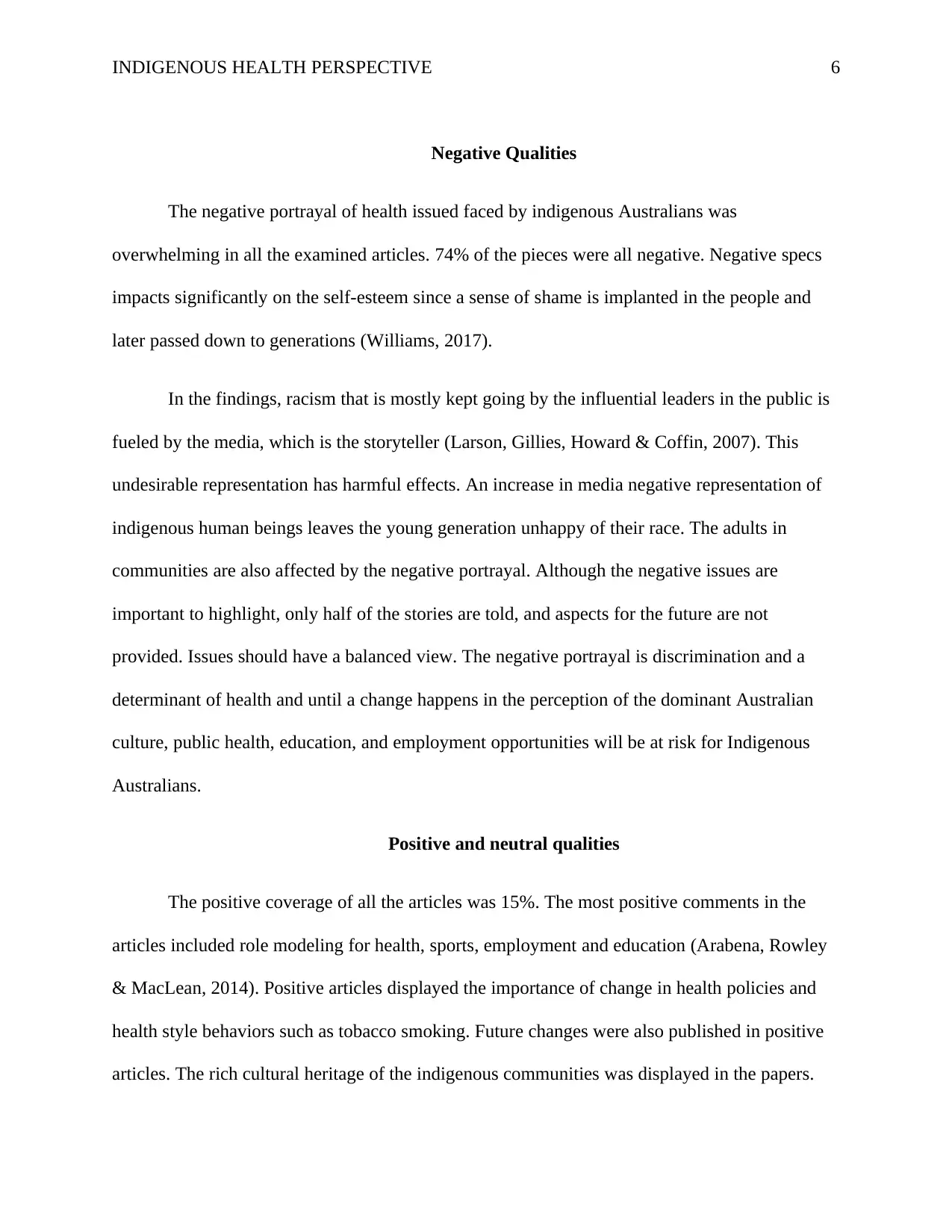
INDIGENOUS HEALTH PERSPECTIVE 6
Negative Qualities
The negative portrayal of health issued faced by indigenous Australians was
overwhelming in all the examined articles. 74% of the pieces were all negative. Negative specs
impacts significantly on the self-esteem since a sense of shame is implanted in the people and
later passed down to generations (Williams, 2017).
In the findings, racism that is mostly kept going by the influential leaders in the public is
fueled by the media, which is the storyteller (Larson, Gillies, Howard & Coffin, 2007). This
undesirable representation has harmful effects. An increase in media negative representation of
indigenous human beings leaves the young generation unhappy of their race. The adults in
communities are also affected by the negative portrayal. Although the negative issues are
important to highlight, only half of the stories are told, and aspects for the future are not
provided. Issues should have a balanced view. The negative portrayal is discrimination and a
determinant of health and until a change happens in the perception of the dominant Australian
culture, public health, education, and employment opportunities will be at risk for Indigenous
Australians.
Positive and neutral qualities
The positive coverage of all the articles was 15%. The most positive comments in the
articles included role modeling for health, sports, employment and education (Arabena, Rowley
& MacLean, 2014). Positive articles displayed the importance of change in health policies and
health style behaviors such as tobacco smoking. Future changes were also published in positive
articles. The rich cultural heritage of the indigenous communities was displayed in the papers.
Negative Qualities
The negative portrayal of health issued faced by indigenous Australians was
overwhelming in all the examined articles. 74% of the pieces were all negative. Negative specs
impacts significantly on the self-esteem since a sense of shame is implanted in the people and
later passed down to generations (Williams, 2017).
In the findings, racism that is mostly kept going by the influential leaders in the public is
fueled by the media, which is the storyteller (Larson, Gillies, Howard & Coffin, 2007). This
undesirable representation has harmful effects. An increase in media negative representation of
indigenous human beings leaves the young generation unhappy of their race. The adults in
communities are also affected by the negative portrayal. Although the negative issues are
important to highlight, only half of the stories are told, and aspects for the future are not
provided. Issues should have a balanced view. The negative portrayal is discrimination and a
determinant of health and until a change happens in the perception of the dominant Australian
culture, public health, education, and employment opportunities will be at risk for Indigenous
Australians.
Positive and neutral qualities
The positive coverage of all the articles was 15%. The most positive comments in the
articles included role modeling for health, sports, employment and education (Arabena, Rowley
& MacLean, 2014). Positive articles displayed the importance of change in health policies and
health style behaviors such as tobacco smoking. Future changes were also published in positive
articles. The rich cultural heritage of the indigenous communities was displayed in the papers.
⊘ This is a preview!⊘
Do you want full access?
Subscribe today to unlock all pages.

Trusted by 1+ million students worldwide
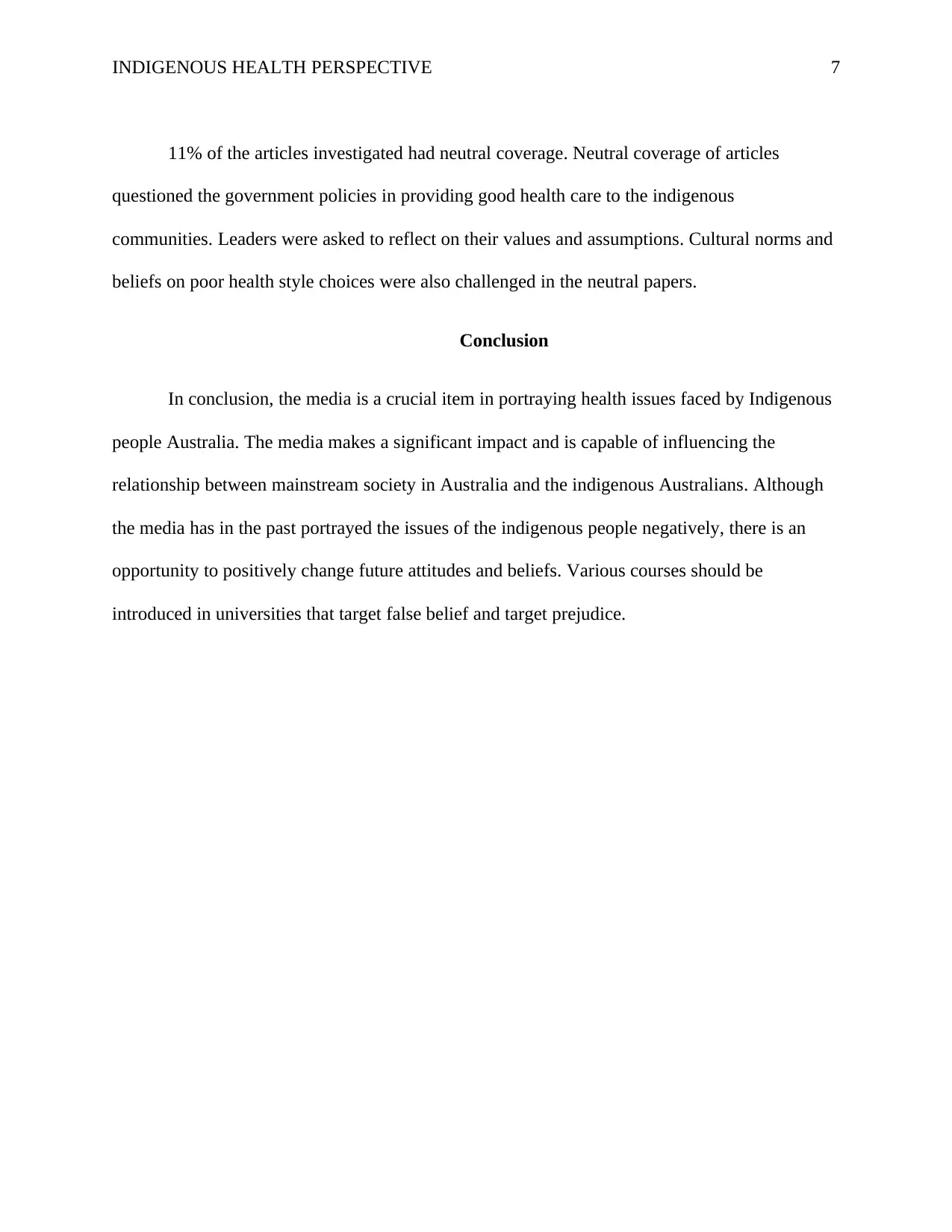
INDIGENOUS HEALTH PERSPECTIVE 7
11% of the articles investigated had neutral coverage. Neutral coverage of articles
questioned the government policies in providing good health care to the indigenous
communities. Leaders were asked to reflect on their values and assumptions. Cultural norms and
beliefs on poor health style choices were also challenged in the neutral papers.
Conclusion
In conclusion, the media is a crucial item in portraying health issues faced by Indigenous
people Australia. The media makes a significant impact and is capable of influencing the
relationship between mainstream society in Australia and the indigenous Australians. Although
the media has in the past portrayed the issues of the indigenous people negatively, there is an
opportunity to positively change future attitudes and beliefs. Various courses should be
introduced in universities that target false belief and target prejudice.
11% of the articles investigated had neutral coverage. Neutral coverage of articles
questioned the government policies in providing good health care to the indigenous
communities. Leaders were asked to reflect on their values and assumptions. Cultural norms and
beliefs on poor health style choices were also challenged in the neutral papers.
Conclusion
In conclusion, the media is a crucial item in portraying health issues faced by Indigenous
people Australia. The media makes a significant impact and is capable of influencing the
relationship between mainstream society in Australia and the indigenous Australians. Although
the media has in the past portrayed the issues of the indigenous people negatively, there is an
opportunity to positively change future attitudes and beliefs. Various courses should be
introduced in universities that target false belief and target prejudice.
Paraphrase This Document
Need a fresh take? Get an instant paraphrase of this document with our AI Paraphraser
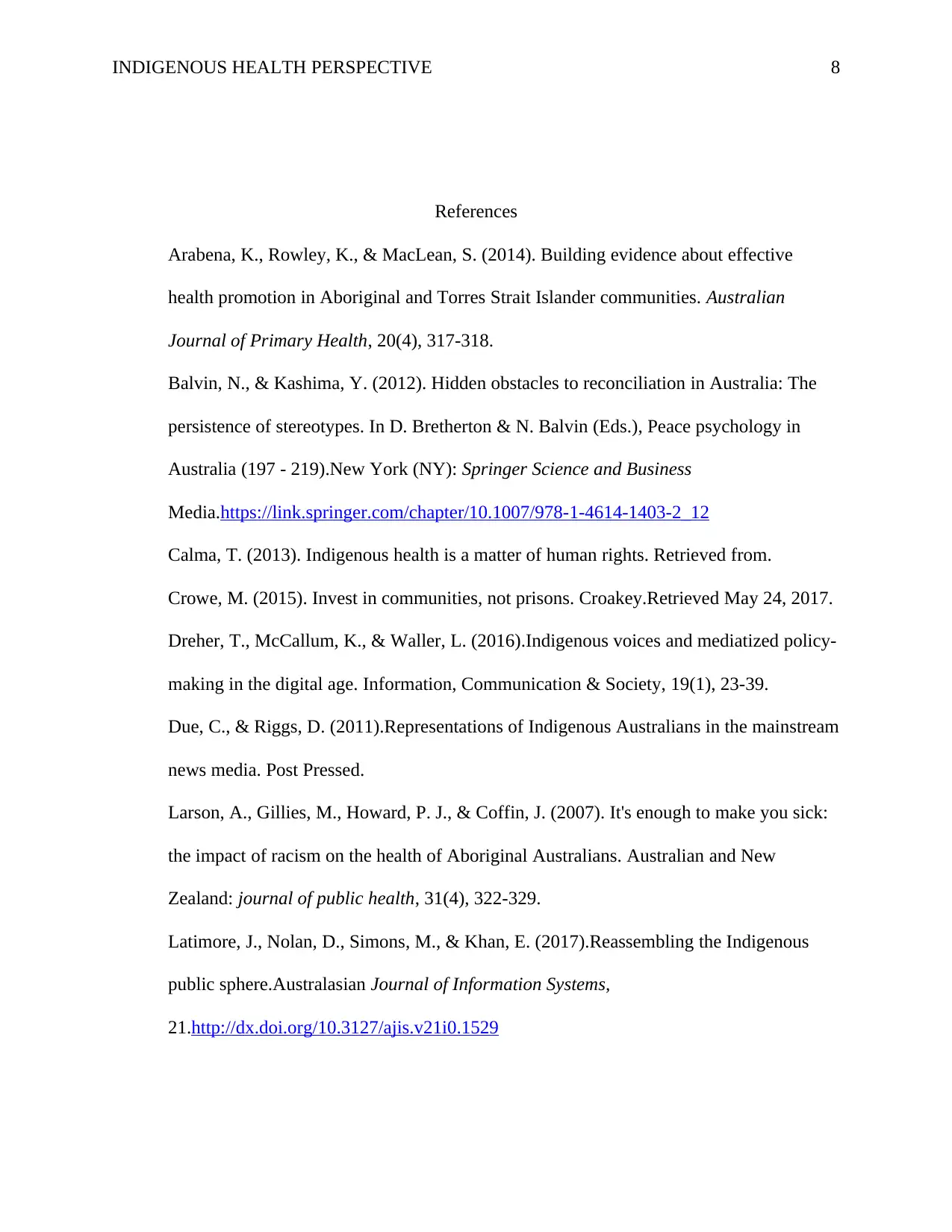
INDIGENOUS HEALTH PERSPECTIVE 8
References
Arabena, K., Rowley, K., & MacLean, S. (2014). Building evidence about effective
health promotion in Aboriginal and Torres Strait Islander communities. Australian
Journal of Primary Health, 20(4), 317-318.
Balvin, N., & Kashima, Y. (2012). Hidden obstacles to reconciliation in Australia: The
persistence of stereotypes. In D. Bretherton & N. Balvin (Eds.), Peace psychology in
Australia (197 - 219).New York (NY): Springer Science and Business
Media.https://link.springer.com/chapter/10.1007/978-1-4614-1403-2_12
Calma, T. (2013). Indigenous health is a matter of human rights. Retrieved from.
Crowe, M. (2015). Invest in communities, not prisons. Croakey.Retrieved May 24, 2017.
Dreher, T., McCallum, K., & Waller, L. (2016).Indigenous voices and mediatized policy-
making in the digital age. Information, Communication & Society, 19(1), 23-39.
Due, C., & Riggs, D. (2011).Representations of Indigenous Australians in the mainstream
news media. Post Pressed.
Larson, A., Gillies, M., Howard, P. J., & Coffin, J. (2007). It's enough to make you sick:
the impact of racism on the health of Aboriginal Australians. Australian and New
Zealand: journal of public health, 31(4), 322-329.
Latimore, J., Nolan, D., Simons, M., & Khan, E. (2017).Reassembling the Indigenous
public sphere.Australasian Journal of Information Systems,
21.http://dx.doi.org/10.3127/ajis.v21i0.1529
References
Arabena, K., Rowley, K., & MacLean, S. (2014). Building evidence about effective
health promotion in Aboriginal and Torres Strait Islander communities. Australian
Journal of Primary Health, 20(4), 317-318.
Balvin, N., & Kashima, Y. (2012). Hidden obstacles to reconciliation in Australia: The
persistence of stereotypes. In D. Bretherton & N. Balvin (Eds.), Peace psychology in
Australia (197 - 219).New York (NY): Springer Science and Business
Media.https://link.springer.com/chapter/10.1007/978-1-4614-1403-2_12
Calma, T. (2013). Indigenous health is a matter of human rights. Retrieved from.
Crowe, M. (2015). Invest in communities, not prisons. Croakey.Retrieved May 24, 2017.
Dreher, T., McCallum, K., & Waller, L. (2016).Indigenous voices and mediatized policy-
making in the digital age. Information, Communication & Society, 19(1), 23-39.
Due, C., & Riggs, D. (2011).Representations of Indigenous Australians in the mainstream
news media. Post Pressed.
Larson, A., Gillies, M., Howard, P. J., & Coffin, J. (2007). It's enough to make you sick:
the impact of racism on the health of Aboriginal Australians. Australian and New
Zealand: journal of public health, 31(4), 322-329.
Latimore, J., Nolan, D., Simons, M., & Khan, E. (2017).Reassembling the Indigenous
public sphere.Australasian Journal of Information Systems,
21.http://dx.doi.org/10.3127/ajis.v21i0.1529
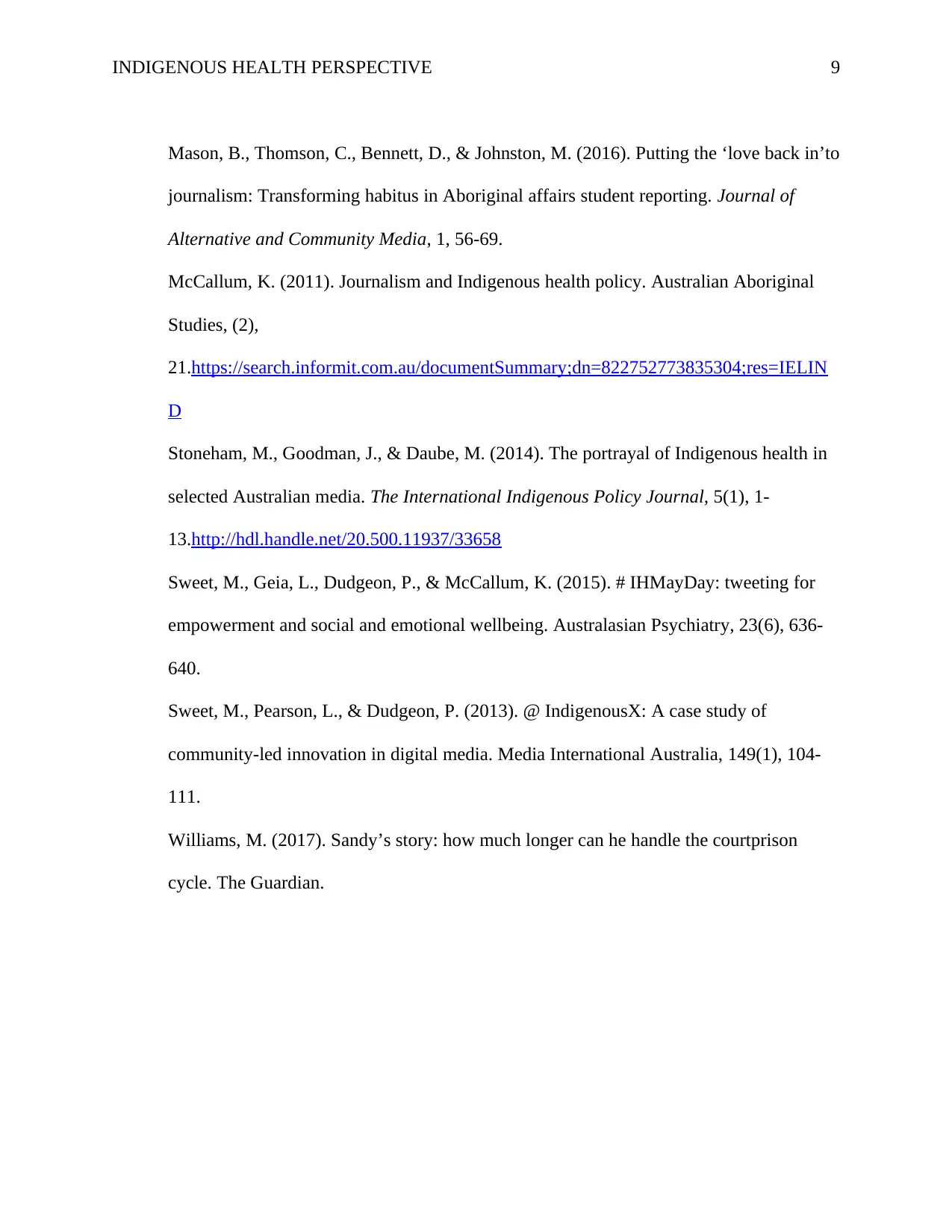
INDIGENOUS HEALTH PERSPECTIVE 9
Mason, B., Thomson, C., Bennett, D., & Johnston, M. (2016). Putting the ‘love back in’to
journalism: Transforming habitus in Aboriginal affairs student reporting. Journal of
Alternative and Community Media, 1, 56-69.
McCallum, K. (2011). Journalism and Indigenous health policy. Australian Aboriginal
Studies, (2),
21.https://search.informit.com.au/documentSummary;dn=822752773835304;res=IELIN
D
Stoneham, M., Goodman, J., & Daube, M. (2014). The portrayal of Indigenous health in
selected Australian media. The International Indigenous Policy Journal, 5(1), 1-
13.http://hdl.handle.net/20.500.11937/33658
Sweet, M., Geia, L., Dudgeon, P., & McCallum, K. (2015). # IHMayDay: tweeting for
empowerment and social and emotional wellbeing. Australasian Psychiatry, 23(6), 636-
640.
Sweet, M., Pearson, L., & Dudgeon, P. (2013). @ IndigenousX: A case study of
community-led innovation in digital media. Media International Australia, 149(1), 104-
111.
Williams, M. (2017). Sandy’s story: how much longer can he handle the courtprison
cycle. The Guardian.
Mason, B., Thomson, C., Bennett, D., & Johnston, M. (2016). Putting the ‘love back in’to
journalism: Transforming habitus in Aboriginal affairs student reporting. Journal of
Alternative and Community Media, 1, 56-69.
McCallum, K. (2011). Journalism and Indigenous health policy. Australian Aboriginal
Studies, (2),
21.https://search.informit.com.au/documentSummary;dn=822752773835304;res=IELIN
D
Stoneham, M., Goodman, J., & Daube, M. (2014). The portrayal of Indigenous health in
selected Australian media. The International Indigenous Policy Journal, 5(1), 1-
13.http://hdl.handle.net/20.500.11937/33658
Sweet, M., Geia, L., Dudgeon, P., & McCallum, K. (2015). # IHMayDay: tweeting for
empowerment and social and emotional wellbeing. Australasian Psychiatry, 23(6), 636-
640.
Sweet, M., Pearson, L., & Dudgeon, P. (2013). @ IndigenousX: A case study of
community-led innovation in digital media. Media International Australia, 149(1), 104-
111.
Williams, M. (2017). Sandy’s story: how much longer can he handle the courtprison
cycle. The Guardian.
⊘ This is a preview!⊘
Do you want full access?
Subscribe today to unlock all pages.

Trusted by 1+ million students worldwide
1 out of 9
Related Documents
Your All-in-One AI-Powered Toolkit for Academic Success.
+13062052269
info@desklib.com
Available 24*7 on WhatsApp / Email
![[object Object]](/_next/static/media/star-bottom.7253800d.svg)
Unlock your academic potential
Copyright © 2020–2025 A2Z Services. All Rights Reserved. Developed and managed by ZUCOL.





